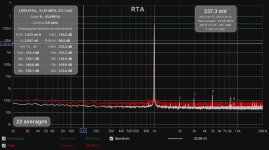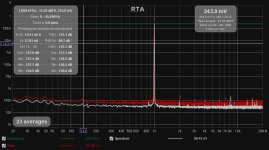Just realized that I tested the attenuation with a Fluke Multimeter, so I should be expecting some measurement error here. 10.62dB in theory and 12dB measured with a multimeter seems to be within measurement error?
Did you accout for source and load impedances in your calculations? There's 220 ohms source, and 47k load, which are not zero and infinite.
I make it about -11.35dB expected. Fluke should be good enough really.
I make it about -11.35dB expected. Fluke should be good enough really.
You are right. The input impedance of the loopback input(motu’s Microphone XLR input has a input impedance of 2.8k ohm). So the attenuation should be ((2.8/3.8)+1.2+1.2)/(2.8/3.8) , which is about 3.52. That is 12.58dB attenuation.
The dynamic range for recordings is quite large, I do not think a fixed attenuator is going to cut it.
Like people discovered long time ago, a variable attenuator is a must.
Like people discovered long time ago, a variable attenuator is a must.
That's right. I'm just trying to attenuate using analog pad when possible, getting a slightly better noise level comparing to digital attenuation. I would have attenuate everything through an analog pot, but I have 8 channels and two sets of amps with different gain, so I wanted to use u-pad to attenuate the amps of different gains and then control the volume of all 8 channels digitally with a remote control. I know that analog volume control is still better, but 8 channel analog volume control that beats digital attenuation is hard to find. And I don't think I'm knowledgable enough to build somethign like a Muses 72323 yet.Like people discovered long time ago, a variable attenuator is a must.
I did a loopback sanity check with motu soundcard. Although the ressitors I use are crappy film resistors, but I guess the result is reasonably good?
Attachments
A newbie question about matching impedance in general: Why in electronic and radiofrequencies we need to match impedance, output Z = input Z otherwise the signal makes an echo
While in audio we are looking for lower output Z and higher input Z? There is not echo in audio signal? Thank you
While in audio we are looking for lower output Z and higher input Z? There is not echo in audio signal? Thank you
At low (audio) frequencies, the transmission line behavior is equivalent to a lumped capacitance and inductance,
so no matching is necessary. This is good, since much gain (6dB per line) would be lost otherwise.
so no matching is necessary. This is good, since much gain (6dB per line) would be lost otherwise.
- Home
- Source & Line
- Analog Line Level
- Impedance Match Question


